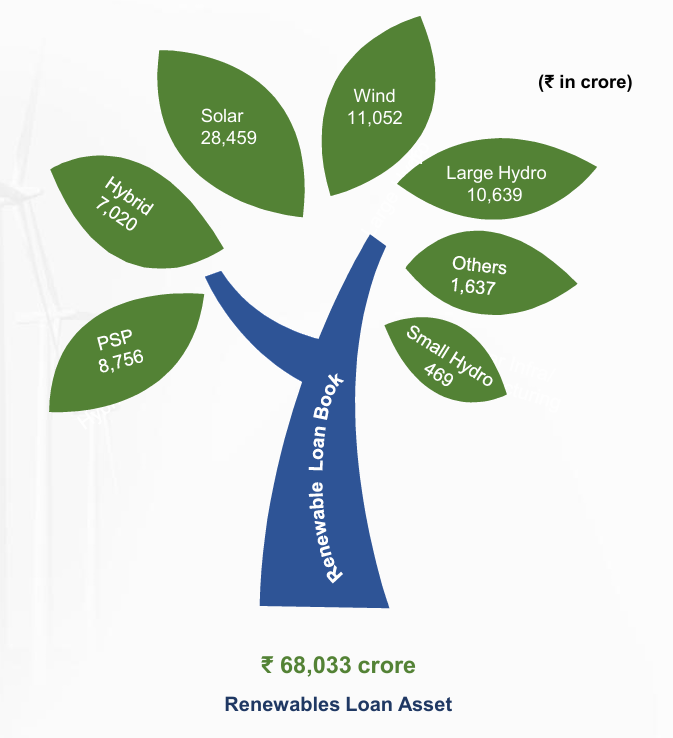REC Profit Up 9.4% in Q2 FY 2026, Renewable Energy Loans Grow 15%
The company’s revenue rises 12% YoY to ₹151.62 billion
October 27, 2025
Follow Mercom India on WhatsApp for exclusive updates on clean energy news and insights
Public infrastructure finance company REC has posted a net profit of ₹44.14 billion (~$530.4 million) for the second quarter (Q2) of the financial year (FY) 2026, up from ₹40.37 billion (~$484.9 million) in the corresponding period of the previous year, reflecting a 9.4% increase.
The company’s total revenue stood at ₹151.6 billion (~$1.82 billion) during the quarter, up from ₹137.06 billion (~$1.65 billion) in Q2 FY25.
The company declared a second interim dividend of ₹4.60 (~$0.055)/share.
Total assets stood at ₹6.40 trillion (~$76.9 billion) as of September 30, 2025, and loan assets reached ₹5.74 trillion (~$69 billion).
REC’s net worth rose to ₹834.80 billion (~$10.03 billion) from ₹783.7 billion (~$9.41 billion) in the previous year.
The debt–equity ratio stood at 6.02 times, while the capital-to-risk-weighted-assets ratio (CRAR) was 23.74%. The gross credit-impaired assets ratio improved to 1.06%, and the net credit-impaired assets ratio declined to 0.24%.
1H
On a half-yearly basis, the total revenue rose to ₹299.8 billion (~$3.60 billion) in the first half (1H) of FY26, up from ₹267.9 billion (~$3.22 billion) in H1 FY25, marking a 12% year-on-year (YoY) growth.
The company recorded a profit of ₹88.77 billion (~$1.07 billion) for the 1H FY26, marking a 19% increase over the ₹74.48 billion (~$894.6 million) profit recorded during the same period last year.
The company’s performance for 1H FY26 reflects strong growth in income, profitability, and asset quality, supported by higher disbursements and improved operational efficiency.
The company’s loan book expanded by 7% to ₹5.82 trillion (~$69.94 billion) as of September 30, 2025, compared to ₹5.46 trillion (~$65.63 billion) in the corresponding period last year. REC’s total disbursements surged by 27% to ₹1.15 trillion (~$13.82 billion), against ₹909.55 billion (~$10.93 billion) in H1 FY25.
Of the total loan portfolio, state-sector loans accounted for ₹4.99 trillion (~$59.96 billion) (86%), while private-sector loans accounted for ₹822.49 billion (~$9.88 billion) (14%), reflecting a balanced exposure mix.
Renewable Energy
The renewable energy segment continued to be a major growth driver, with disbursements of ₹130.42 billion (~$1.57 billion) in 1H FY26, a 15% YoY. The loan book for the sector reached ₹680.33 billion (~$8.18 billion), up 49% compared to the previous year.
REC has financed renewable energy projects with a cumulative capacity exceeding 61,400 MW, comprising 26,213 MW of solar projects, 7,024 MW of wind projects, 18,310 MW of hydro and pumped storage projects, 9,242 MW of hybrid systems, and 617 MW from other renewable sources.
The company’s renewable energy exposure included ₹284.59 billion (~$3.42 billion) in solar, ₹110.52 billion (~$1.33 billion) in wind, and ₹106.39 billion (~$1.28 billion) in hydro and pumped storage projects.
REC’s total renewable energy loan book has grown more than threefold over the past five years. The company has supported renewable projects worth ₹822.75 billion (~$9.89 billion) cumulatively.
Transmission
In the transmission segment, disbursements during H1 FY26 stood at ₹26.58 billion (~$319.4 million), down 32% from the previous year, reflecting the completion of several major projects financed in earlier periods. The loan assets for this segment were ₹440.83 billion (~$5.30 billion), accounting for 8% of the total loan book.
The company continues to support high-voltage transmission corridors under the Green Energy Corridor program and various state transmission utility upgradation projects. REC’s transmission financing is supporting the grid integration of 52 GW of renewable capacity under development.
Distribution
The distribution sector remained REC’s largest portfolio segment, with loan assets totaling ₹2.36 trillion (~$28.37 billion), accounting for 40% of the total loan book. Disbursements in this category rose sharply to ₹797.76 billion (~$9.58 billion) in 1H FY26 from ₹460.17 billion (~$5.53 billion) in 1H FY25, a 73% year-on-year increase.
State utilities account for 86% of REC’s total distribution portfolio. The funding continues to enable infrastructure modernization, smart metering, and financial stability in discoms.
Borrowings
Total borrowings stood at ₹5.07 trillion (~$60.94 billion) as of September 2025, compared to ₹4.75 trillion (~$57.09 billion) a year earlier. Domestic bonds accounted for ₹2.85 trillion (~$34.25 billion) or 56% of total borrowings, external commercial borrowings ₹1.31 trillion (~$15.74 billion) (26%), and term loans ₹637.9 billion (~$7.66 billion) (13%). REC’s provision coverage ratio improved to 77.06% in Q2 FY26 from 71.73% in March 2025.
REC reported its highest-ever quarterly net profit of ₹44.51 billion (~$514.09 million) for the first quarter of FY26, a 29% increase from ₹34.42 billion (~$397.55 million) during the same period in the previous year.
It recorded a total income of ₹153.48 billion (~$1.79 billion) for the fourth quarter of FY25, a 21% year-over-year increase.

